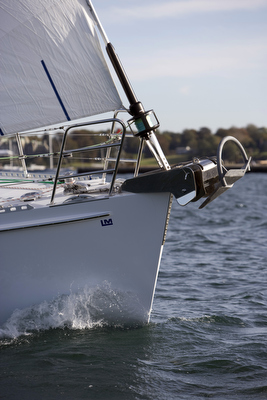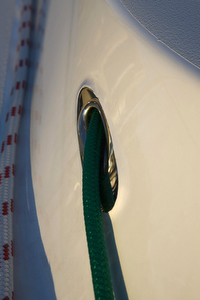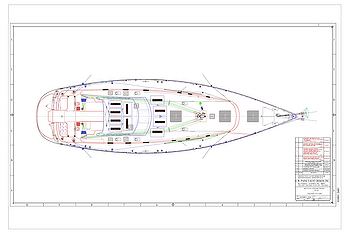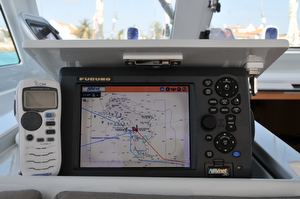The cockpit design exceeded our expectations and is a continual source of enjoyment. The challenge was to create an enjoyable living space when at anchor and a safe, efficient working area while underway. I’m happy to say we achieved both of those goals.
At anchor we begin with two benches, one on each side and both over 7’ long. Long enough to stretch out for an afternoon nap, or to comfortably seat 8 people for dinner. The forward half is covered by the hard dodger to provide sun/wind/rain protection and with the bimini in place the entire cockpit is shaded. The windows have 3M Prestige 70 film applied on the inside which effectively cuts most of the UV heat rays but has very little impact on the visual light so it doesn’t reduce our night vision. The adjustable opening window at the forward end provides plenty of fresh air on almost any point of sail.
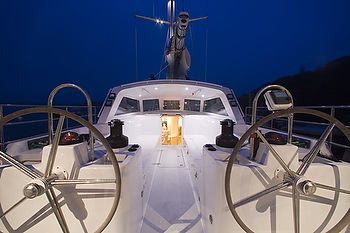
We have two cockpit tables which mount onto poles that screw into sockets in the cockpit sole. The first is a cocktail sized table that we use for dinner when it’s just Fay and I, or to put out snacks for a larger group. The larger table is used either as a snacks/drinks table when the sides are folded in, or seats up to eight for dinner when the sides are folded out. Both tables are air cored fiberglass and light enough to be setup by one person. In temperate climates we spend much of our day in the cockpit and it’s proven to be a wonderful living space.
The other design element of the cockpit that contributes to enjoyment on the hook is the dual wheels and single level sole. We have an unimpeded path from the swim platform to the companionway; nothing to step over or around. When we’re on the hook, the swim platform is our front door. The dinghy is tethered aft, visitors enter and depart via the swim platform (much easier than climbing over the side) and of course we use it as a swim platform! We have our snorkeling and dive gear stored on the starboard side aft and it’s our gateway to the water. When we return from a swim we use the transom hand shower to rinse off our gear and ourselves.
The second design goal of the cockpit was to be a safe, efficient work area while underway. In this regard there was a lot of interaction with the deck plan which was developed with the help of Scott Easom at Easom Rigging. The overriding goal was to keep the decks simple and uncluttered. Let’s go through it quickly from bow to stern.
The anchor roller at the stem has paths for two anchors, and a pad eye in the middle for the spinnaker tack. A Rocna 55kg (121lbs) anchor sits in the port side and the starboard side is used for either a snubber or second anchor. Two Nomen cleats, which fold to a graceful arch when not in use, are located to port and starboard. They are positioned on the rail, without fairleads, to accept lines from a wide range of angles. The same cleats are used mid-ship and aft, but with fairleads. A Lewmar V5 vertical windlass with capstan (controlled by deck mounted switches with hinged covers) is located in the center with a stainless steel plate protecting the deck from the windlass to the bow roller. A small chain break is mounted forward of the windlass for use on short hops or as a backup to the large retaining pin on the anchor roller.
Just aft of the windlass is the bow locker which provides storage for sails, pasarelle, inflatable dinghy, access to the chain locker, boat hook, deck brushes, dock lines, fenders, etc. And just aft of the locker are dual pad eyes for the inner forestay and staysail tack. Next are two large hatches which provide light and air for the forward cabin. On the hook we have an awning for the second hatch which enables us to leave it open all night and get plenty of fresh air while still being protected from passing rain squalls.
Exiting at the port and starboard side of the forward end of the house are what we call our multipurpose lines. These lines are controlled from the cockpit, and lead forward either directly to the bow roller to be used for the spinnaker tack, or via snatch blocks on pad eyes and the toe rail when used as a foreguy, preventer or for jib car adjustment. The detail in the drawing is not entirely accurate as the lines are lead forward before turning aft. They are truly multipurpose!
Moving further aft we come to the mast. On the forward side of the mast is the spinnaker pole (carbon fiber with Hall Spars end fittings) with the butt attached to a Harken car and track which is raised and lowered by an Antal line adjuster. A winch is located on the deck to the port side of the mast. This winch is used for the port spinnaker halyard, pole lift / staysail halyard, jib halyard and cunningham. The spinnaker and staysail halyards lead through Spinlock clutches to the winch and in practice we use them primarily to hoist the dinghy out of the water (every night), and to support the hatch cover. The jib halyard terminates to a car on a section of Antal “automatic” track on the port side of the mast and a short line from the winch is used to adjust the car position and tension the halyard. The Antal “automatic” car/track acts as a ratchet to maintain the halyard tension after we release the line from the winch. When we’re finished sailing we use the winch to take the load, then release the car and unload the halyard tension. The same line is used to attach to a “dog bone” on the luff of the main and act as a cunningham.
At the base of the mast are two clusters of turning blocks which lead the main halyard, starboard spinnaker halyard and all reef lines aft to the cockpit through a trough mounted to the underside of the deck. When/if necessary the trough can be accessed at various points to re-lead a line (yes – we’ve had to do this…).
Click on the drawing to download the PDF and use Acrobat to turn layers on/off.
On either side deck is another section of Antal automatic track. When used with the multipurpose line the car can be moved forward to adjust the jib lead, ratcheting as it moves. Then when in the desired position, the car holds itself in place. This gives us the ability to move the car forward when shortening sail without the need to go to the foredeck and without having the car adjustment line constantly under load. When unfurling sail and we want to move the car back, we go forward and adjust it like a pin stop car. The cars are large enough to accommodate two lines so we can lead both the jib sheet and a staysail or reaching sheet through the single lead. A pair of Harken double cheek blocks guide the sheets back to the cockpit.
At the aft end of the dodger is the mainsheet arch, built of carbon fiber and integrated into the dodger. Blocks on pad eyes provide 3:1 purchase on the main sheet which then leads down through the vertical portion of the port side of the arch and back to the cockpit.
The cockpit itself has six Harken two-speed 24v electric winches (all of which can also be operated manually). Two primary winches, positioned on the outboard end of the peninsulas, are used for jib sheet and staysail sheets (with sheet bins below and slightly aft) and two secondary winches for spinnaker sheets, running back stays, jib furler and miscellaneous tasks.
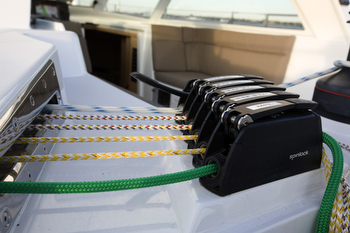
The utility winches on the inboard end of the cockpit peninsulas are the real work horses and get lots of usage. The port side controls the main sheet, port multipurpose line, and 2nd and 3rd reef tack and clew lines. The starboard side controls the main halyard, starboard spinnaker halyard, staroard multipurpose lines, and 1st reef tack and clew lines.
On the aft side of the peninsulas are the bulkhead mounted wheels. Both wheels have devices which allow them to be disengaged from the hub. Disengaging the wheels entirely eliminates the flywheel effect from the steering system which significantly reduces the effort required by the autopilot while also reducing the “whiplash” within the cable portion of the steering system. On passage we normally have both wheels disengaged and rely on the autopilot since it is very easy to re-engage a wheel on short notice if necessary.
Finally, on the port side below the jib sheet bin is a three position Navtec hydraulic pump controller for the backstay, vang and outhaul.
The reefing system deserves a paragraph (or two) of its own. After considering various mainsail furling systems I concluded that they all had too many moving parts, any one of which could cause total failure and most of which could not be repaired while at sea. Our previous boat had single line slab reefing and I found that with only a single line it was not possible to fully control the sail, the clew and tack would rise and fall depending on the point of sail. This led to the decision to rig New Morning with two line slab reefing for all three reefs. The challenge with two reef lines and three reefs on a big sail is to manage all the line. Setting the first reef requires 120’ of line to be stowed. The first way we manage this is that New Morning has two large sheet bins integrated into each of the cockpit peninsulas that provide more than enough capacity for all the tails. Then credit goes to Scott Easom at Easom Rigging for designing the reef lines themselves. Each line consists of four sections. The first section which runs through the reef cringle is basic Spectra line with an additional layer of chafe cover. The next portion, which runs almost to the winches has the cover stripped so it’s just Spectra core. The third portion has the standard cover and then Maffioli Swiftcord tails are spliced onto the bitter ends. The Swiftcord is the real secret ingredient.
Here is how we take the first reef which is about 10’ above the foot of the sail. We head up to at least 70 degrees TWA as necessary, fully ease the main sheet and then lower the main halyard about 5’ and pull 60’ of Swiftcord tail through the clutches and into the bins. The Swiftcord tails very smoothly, has a soft hand and never hockles. Then we lower the halyard until the first reef cringle is at the tack, or even below it, better too low than too high. We haul in all the slack in the second and third reef tack and clew lines, another 40’ of line, but leave the clutches open. Then we pull in the first reef tack line to a marked point (yellow whipping) and close its clutch, this does not require any winching. At this point we have the reef line with cover through the clutch. Then we tension the main halyard with the winch, putting a full load on the tack. Next we ease the vang to allow the end of the boom to rise and pull the clew line hand tight, then use the winch to pull it through to a marked point (marked to ensure there is sufficient line between the cringle and where the line terminates on the boom). Again there is reef line with cover through the clutch and the marks on the tack and clew lines take the guess work out of tensioning those lines, particularly at night. Then we haul in the main sheet, resume course, adjust the vang and sheet as necessary and close the clutches on the 2nd and 3rd reef tack and clew lines.
The cockpit arrangement allows all of the work to be done from the center of the cockpit, in a very secure location between the two peninsulas, working with lines, clutches and winches which are all at waist height. There is no bending or hyper extending; everything is within arms reach. There are no mast of boom mounted mechanical pieces to fail and bringing in the tails in two steps ensures that the lines don’t foul on anything while the sail is flogging.
Coming full circle back to the cockpit is our watch standing station. When on passage the autopilot does the steering while we focus on navigation and sail trim (or ignore it all and read a book or listen to a podcast). From our watch standing station at the forward end of the port side cockpit bench we have an excellent view in all directions and can control the autopilot with a wireless remote control. A Furuno Navnet 3D MFD pops up to provide us with a chart plotter, AIS , dual range radar and boat instrument data (wind, speed, etc.). A remote microphone for the VHF is also located here. Opposite our watch seat, and below the forward end of the starboard bench, is the panel for the Yanmar engine, allowing us to monitor engine RPM, oil pressure, water temp and fuel filter vacuum pressure.
When we started this project we were concerned about our ability to manage a 54’ boat under sail, but the combination of deck plan and cockpit design came together to make New Morning very easy to handle while also providing us with a large and protected living space when at anchor.

